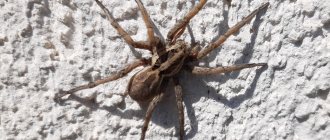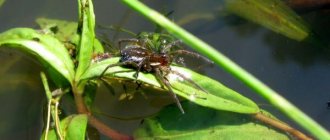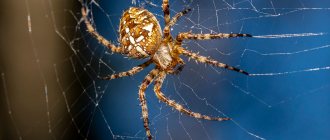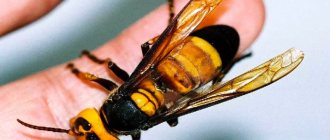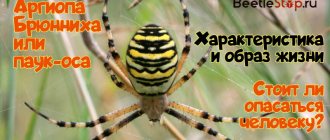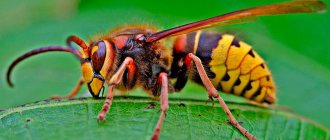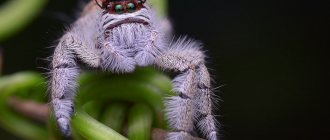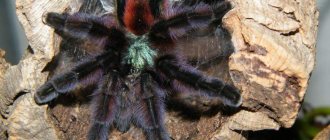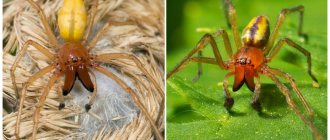The cross spider is a representative of the suborder of araneomorphic spiders of the orb-weaver family. There are more than 600 species of these arthropods in the world. The distribution area of the crusaders is quite extensive - they can be found on almost all continents except Antarctica. About 30 species of these arachnids live in our latitudes.
Spiders of this genus represent a striking case of sexual dimorphism. In addition to differences in the genitals, two heterosexual crosses differ in size, color, habits and other characteristics. After reading this article to the end, readers will become familiar with many interesting details from the life of these tiny creatures, and will also find out how dangerous a spider bite is for humans.
Origin of the species and description
Photo: Cross spider
Cross spiders are representatives of the order of spiders, suborder of araneomorphic spiders, family Araneidae, genus of cross spiders.
To date, scientists can only approximately indicate the period of appearance of ancient arthropods. The chitinous shell of these representatives of flora and fauna disintegrates quite quickly, leaving virtually no traces. A few remains of ancient arthropods were discovered in pieces of frozen resin, or in amber. Today, zoologists call the approximate period of the appearance of arachnids - 200-230 million years ago. The first spiders had very small body sizes, which did not exceed half a centimeter.
Video: Cross spider
Their body structure was also significantly different from modern ones. Spiders of that time had a tail, which was intended for making strong web threads. The so-called web was used to line their burrows, or shelters, and also to protect the clutch of eggs from damage and extinction. During the process of evolution, the tail part of ancient arthropods disappeared. However, the modern spinning machine they have now did not appear immediately.
The first spiders supposedly appeared on Gondwana. Then they very quickly spread across almost the entire landmass. Subsequent ice ages significantly narrowed the regions of their residence. Arthropods are characterized by a fairly rapid evolution, during which spiders changed in appearance depending on the region they lived in, as well as on belonging to a particular species.
Toxicity
Its venom is toxic to us and about five minutes after the bite you can feel the following unpleasant symptoms.
Symptoms
If your health deteriorates seriously, it is recommended to consult a specialist, as there is a risk of complications. Most often, more unpleasant symptoms appear in children and people with weakened immune systems. The child is at high risk of an allergic reaction. Symptoms include:
- Itching. It almost always occurs, but the degree of discomfort can vary greatly.
- Sharp and chaotic headaches. Possible dizziness and short-term disorientation.
- Joint pain. This especially applies to older people suffering from joint diseases (for example, arthrosis or arthritis).
- Change in body temperature. In the absence of a severe allergic reaction, in most cases there is a slight increase.
- Slight weakness. Less commonly, minor apathy and increased drowsiness may occur.
It is worth noting that some pets are practically not sensitive to the bites of this arachnid. This applies to dogs, guinea pigs, horses and sheep. It is also necessary to pay attention to the fact that the pain of the bite can vary. This depends on the size and variety of the crusader. It is believed that bites from large individuals can be extremely painful, on par with much more dangerous arthropods.
Appearance and features
Photo: Large cross spider
Like other representatives of arachnids, the body of the cross is divided into two segments: the cephalothorax and abdomen. In addition, they have arachnoid warts and a walking apparatus, the latter being represented by the femur, knee joint, tibia, forearms, tarsi and claw. Spiders also have chelicerae and pedipalps.
Crosses have fairly small body sizes. Representatives of this species have pronounced sexual dimorphism - males are significantly inferior to females in body size. The average body length of a female individual is 2.0-4.5 cm, and that of a male individual is 1.0-1.2 cm.
The body of the arthropod is covered with a sand-colored chitinous shell, which insects typically shed during the molting period.
Spiders have 12 limbs:
- one pair of chelicerae, the main purpose of which is to fix and kill caught prey. This pair of legs points downwards;
- four pairs of walking limbs that have claws at the tips;
- one pair of pedipalps, which are designed for fixing their prey. It is noteworthy that on the last segment of these limbs in males there is a reservoir into which seminal fluid enters, which is subsequently transferred to the spermatheca of the female.
Crosses have as many as four pairs of eyes, but they are poorly developed. The vision of these representatives of arthropods is poorly developed; they can only distinguish silhouettes and general outlines. The reference point in the surrounding space is the sense of touch. This function is performed by hairs that cover almost the entire body.
Interesting fact: Spiders have a huge variety of hairs of different types on their bodies. Each type is responsible for receiving certain types of information: light, sound, movement, etc.
The abdomen of the cross has a round shape. It is missing any segments. On the upper surface there is a clearly defined pattern in the form of a cross. In its lower part there are three pairs of special arachnoid warts. It is into these warts that thousands of glands open, which produce strong, reliable arachnoid threads.
The respiratory system is located in the abdomen and is represented by two pulmonary sacs and a tracheal tube. The heart is located in the back area. It has the shape of a tube and vessels branching from it.
Rules for treating a bite
Providing first aid can help relieve unpleasant symptoms and reduce the risk of infection. To avoid dangerous consequences, it is recommended to follow the following treatment plan:
- rinse the wound with clean water without any impurities;
- apply something cold to the bite site (helps reduce the inflammatory process and slow down the spread of poison throughout the body);
- If adverse symptoms occur, the use of appropriate medications is allowed.
The allergic reaction is most often quite mild, so any antihistamines can be used for relief. It is important to consider that young children often react more strongly. It is highly not recommended to treat a child on your own.
What not to do
Cauterizing the bite site is ineffective and increases pain. This leaves wounds that take much longer to heal. Thus, such a measure only brings harm.
In addition, it is useless to make cuts, which have the same consequences as with thermal exposure. If the inflamed area is itchy, then it is not recommended to scratch it, because this can cause an infection and provoke increased inflammation.
Consequences
Krestovik releases epeirotoxin , which is absorbed and completely eliminated from the human body within 24 hours. There may be slight swelling at the site of the bite for several days.
If there is no improvement in the person’s condition, the following actions should be taken:
- apply cold to the affected area;
- use anti-inflammatory ointments: Sinaflan, Kremgen;
- Lubricate the area with alcohol.
To date, not a single fatality has been reported from a cross bite.
But in some cases, after recovery, soft tissue necrosis is observed at the affected area. Exercise caution when out in nature. Remember that a cross spider will never attack a person on its own. Do not provoke a bite, and if affected, take measures to prevent complications.
Where does the cross spider live?
Photo: Cross spider in Russia
Spiders of this species are characterized by a ubiquitous distribution. They live in almost every country in Eurasia. Also quite common in North America.
Crosses prefer areas with high humidity, little sunlight and high air temperatures. Spiders love to mingle on the edges of forests, meadows, gardens, and fields. Human housing is no exception. Once in living spaces, spiders climb into crevices or joints between walls, inaccessible places, spaces between furniture and walls, etc. Crossworts can often be found on various types of vegetation located near a body of water.
Geographical regions:
- territory of almost all of Europe;
- Russia;
- Africa;
- Asian countries;
- North America.
Spiders prefer to settle in places where it is easy and convenient to weave their fishing nets, which are likely to catch a sufficient number of insects. In Russia, crosses are often found in city parks and squares.
Now you know where the cross spider lives. Let's see what he eats.
Benefits for humans
People actively use the web of crosses. It is ideal for sighters of various optical instruments: microscopes, telescopic sights. And microbiologists, with its help, invented an innovative air analyzer.
The crosser is placed on a special frame, fed, and he weaves his net on its basis. Then a portion of air is passed through this frame, and the thinnest web traps pathogenic microorganisms that fill the air space. This method of air analysis has been recognized as the most effective of all existing in the world.
Folk healers have long used spider webs to disinfect open wounds. Over time, medical research has confirmed that spider webs actually kill pathogenic bacteria. Based on it, drugs were developed that are harmless to animals, but destructive to all kinds of bacteria.
What does the cross spider eat?
Photo: Cross spider in nature
The cross is far from a harmless representative of arthropods. It belongs to the poisonous species of arachnids, and by nature is considered a hunter. It goes hunting most often at night.
What is the food source:
- flies;
- mosquitoes;
- butterflies;
- vile;
- aphid.
When going hunting, the cross is located in the central part of the web and freezes. If you observe him during this period of time, he appears to be dead. However, if the prey gets caught in the net, the spider plunges its front pair of limbs into it with lightning speed, injecting poison. After a short period of time, the potential food stops resisting. Crossbills can eat it right away or leave it for later.
These representatives of arachnids are considered voracious. To be satisfied, they need an amount of food per day that exceeds their own body weight. For this reason, spiders spend most of the day hunting. They rest mostly during the day. Even during the rest period, the signal thread is always tied to one of the limbs of the cross.
Interesting fact: The cross spider does not eat everyone who falls into its trapping nets. If a poisonous insect, or one that emits an unpleasant odor, or a huge insect gets caught in them, the spider simply bites through the fixing threads and lets it go.
Arthropods have an external type of digestive tract. They cannot digest food on their own. They tend to partially digest it with the help of injected poison. Only after the insides of the caught insect turn into a liquid substance under the influence of the toxin do the spiders drink it. Also, spiders often, after paralyzing the victim, wrap it in a cocoon of their web. The process of partial digestion also occurs in it.
Nutrition composition
The basis of the cross's diet is small insects. In addition to them, the arthropod also eats other representatives of the fauna. Species that the cross spider feeds on:
- aphid;
- flies;
- wasps;
- small beetles;
- fruit flies;
- grasshoppers;
- dragonflies;
- bees;
- mosquitoes
To get food for itself, the spider weaves a strong hunting web. Sometimes insects that are too large are caught in it and are able to pierce the body of the cross and lay eggs in it. In this case, the arthropod breaks the threads so that the dangerous prey can fly away.
The hunt goes like this: the individual hides in a secluded place where the threads from the main web are stretched. When prey gets caught in the net, it begins to make chaotic movements, trying to get out. The vibrations are transmitted to the spider, it approaches the victim and pierces it with its jaw apparatus.
The crusader's digestive system is designed in such a way that food is digested before it enters the spider's body. It injects digestive juice into the prey , after which the digestion process begins. When the prey's organs dissolve, the arthropod sucks out the semi-liquid contents and becomes saturated. If the cross is not hungry, it does not inject poison into its prey, but kills it and wraps it in a cocoon, then hides it in a place inaccessible to other forest inhabitants.
Features of character and lifestyle
Photo: Common cross spider
Spiders are nocturnal arthropods, which tend to be most active at night. They spend most of their time hunting and have little rest. As habitats, be sure to choose places where there is a lot of moisture and little sunlight.
Webs are often woven between the branches of bushes, trees, various types of vegetation, blades of grass, etc. They themselves settle down in a secluded place near their fishing net. The web threads that crosses can weave have great strength and are capable of holding even fairly large insects, whose dimensions are several times larger than the size of the body of the spider itself.
Crossers are considered real hard workers, as they tirelessly weave their web. They tend to weave huge webs. Once they become unsuitable for catching prey, they scatter it and weave new nets.
Interesting fact: The spider will never get entangled in its own trapping nets, since it always moves strictly along a certain trajectory of non-sticky areas.
Spiders also weave webs mainly at night. This is due to the fact that the main enemies of crosses are diurnal and hunt them during daylight hours. In the process of forming a trapping network, spiders show accuracy, detail and scrupulousness. In the process of their life, they rely not on vision, but on touch. Krestovik lead an exclusively solitary lifestyle.
Lifestyle
The common cross spider is a resident of the wild, but under certain circumstances it settles in the house. Leads a nocturnal lifestyle, during the day it sits motionless in a shelter or on a web of cobwebs. He weaves it at night. It makes a shelter out of leaves and builds trapping nets between the branches.
Experts managed to find out how the female cross weaves a web. The network consists of 39 different radii, which expand as they move away from the center, 35 spiral turns, 1245 points of contact of threads. The radius of the web of the large Far Eastern cross reaches up to 2 m.
Interesting!
At night the female weaves a net, and during the day it catches prey. The spider eliminates the damaged areas and forms new coils in their place. Natural enemies are birds, but with the onset of darkness their activity decreases. The cross can work quietly.
Social structure and reproduction
Photo: Cross spider
Throughout the spring and summer, males are busy forming webs and ensuring a sufficient amount of food. During the mating season, males leave their shelters and begin to actively look for a female to mate with. During this period, they eat practically nothing, which explains such a significant difference between male and female individuals.
Crossworts are dioecious arthropods. The period of mating relations and courtship of females often occurs at night. It consists of males performing peculiar dances that involve tapping their limbs. After the male manages to reach the head of the female with his limbs, the transfer of seminal fluid occurs. After mating, most males die from the poisonous secretion of the female.
The period of marriage occurs at the end of the summer season, the beginning of autumn. The female makes a cocoon from the web in which she places her eggs. One cocoon can contain from 3 to 7 hundred honey-colored eggs. At first, the female wears this cocoon on herself, then finds a secluded place and hides it. The cocoon reliably hides future offspring from rain, wind and cold. In the spring, spiderlings begin to emerge from the eggs. They stay inside the cocoon for a short period of time, then come out of it and crawl away in different directions. Little crosses immediately become independent and lead an isolated lifestyle.
After the spiderlings leave the cocoon, they try to separate as quickly as possible. Due to high competition and the possibility of becoming food for older individuals, such a step will significantly increase the chance of survival.
Interesting fact: Due to the fact that newly born young individuals have rather small and weak limbs, in order to separate from each other they use a web, on which they can fly up to several hundred kilometers, provided there is wind.
Crosses adapt well to new conditions. It is because of this that lovers of exotic flora and fauna often keep them as pets. To maintain them, a terrarium of sufficient size is used to provide space for a fairly large web.
How long do they live?
The lifespan of a cross spider can vary greatly. Most individuals die young due to other predators or adverse weather conditions. However, if we talk about death from old age, this arachnid can live 10-12 months. There are individuals whose lifespan is as much as 2 years.
It should also be taken into account that most males are eaten after mating. Thus, their lifespan is only about 3 months. Females most often die immediately or some time after creating a cocoon, i.e. they live for about 6 months.
Natural enemies of cross spiders
Photo: Female cross spider
Despite the fact that the crusader is classified as a dangerous, poisonous spider, it also has enemies. It is in order to reduce the likelihood of being eaten that they are most active at night. The main enemies of this type of arthropod can be called birds, as well as insects - parasites. Some species and flies wait until the spider freezes on its web in anticipation of its next victim, fly up to it and instantly lay eggs on its body.
Subsequently, parasitic larvae emerge from them, which, in fact, feed on the insides of the spider. When the number of parasites increases, they practically eat the spider alive. Crusaders are small in size, which often leads to them themselves becoming prey to other, larger arachnids. Some amphibians, such as lizards or toads, can also be considered enemies of the crusaders.
The main enemies of the cross spider in natural conditions:
- salamanders;
- geckos;
- iguanas;
- frogs;
- hedgehogs;
- the bats;
- ants.
Man is not the spider's enemy. Rather, crusaders in some cases can cause harm to human health. It is unusual for them to attack first. When meeting a person, these representatives of arthropods rush to hide. However, if they sense danger, they attack. A healthy adult will not die as a result of a bite, however, they will definitely feel discomfort and a change in their general well-being.
The consequence of a cross bite is pain, dizziness, nausea, vomiting, swelling, and suppuration of the bite site. Most often, all of the above symptoms disappear without drug treatment.
Interesting Facts
A spider with a cross has the following features:
- The web of the cross is of great interest. It is elastic and has high strength. Since ancient times it has been used to make fabrics or decorations. People from tropical countries weave nets and nets from it to catch fish.
- Microbiologists have also not ignored the spider web. They use it to determine the composition of atmospheric air, as well as to produce the thinnest optical fiber.
- Interestingly, spiders move freely through their trapping webs and do not stick to them. This is explained by the fact that they move along radial, dry threads.
Crossmen are unique creatures. They can be very useful for a person. But if, due to an unfortunate combination of circumstances, the arthropod still bites, then first aid measures should be taken. But there is no reason to seriously fear for your health after this.
Structure
The cephalothorax is covered with a thick and durable cephalothorax shield, in the front of which there are eight simple eyes. The body is covered with a layer of waxy substance that prevents water evaporation. The male is smaller than the female and differs from her by the strong swelling at the ends of the pedipalps, as well as a much smaller and more elongated abdomen, longer legs and the inability to catch or eat prey larger than itself.
Digestion is external - like all spiders, the common spider cannot digest. Therefore, it releases its digestive juices into the victim’s body. While the victim is wrapped in the web, it is digested. The spider just has to drink the resulting nutrient solution.
Precautionary measures
Although in general the crusader spider is not dangerous to humans, its bite can cause some discomfort. When going for a walk, you need to take care not to become a victim. Rules to follow:
- If you plan to spend the night in a tent, shortly before going to bed you should check whether spiders have climbed inside. Before getting dressed and putting on your shoes, it is very advisable to look around all your clothes, turn them inside out and make sure that there is no cross anywhere.
- Bedding needs to be very carefully and carefully straightened, as females can hide in the folds. If you see a web, you should not touch it, as the female may attack. Males are more peaceful, and they do not weave nets.
- If you encounter an arthropod, it is better not to react to it in any way. You should not run away; you should try to carefully move away so as not to disturb the forest dweller.
Thus, the cross spider is poisonous, but it does not pose a danger to humans. You still need to take precautions, because those who are prone to allergies may develop unpleasant symptoms, although without serious consequences.
